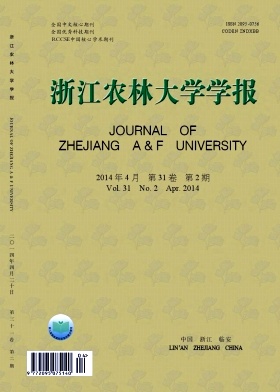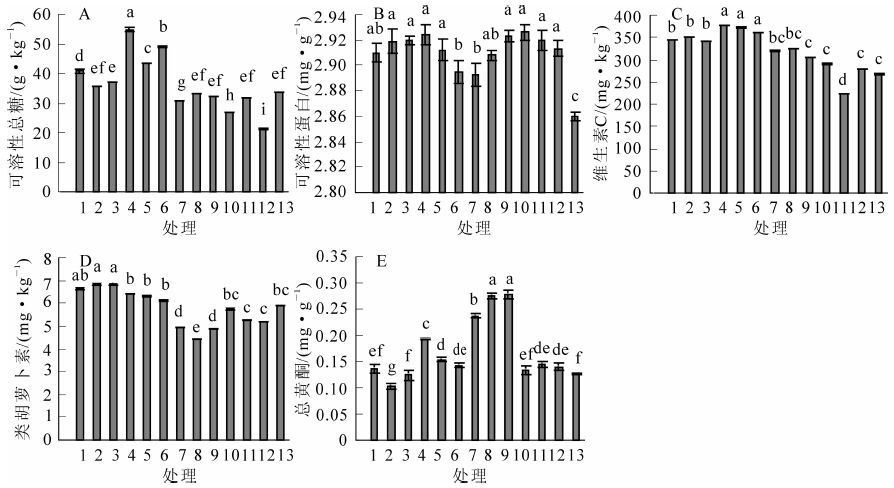-
华东地区的设施越冬栽培大多以非加温的塑料大棚为主,冬春季节低温弱光、阴雨高湿天气较多,大棚内光照往往不能满足作物生长的需求,人工补光成为众多可控环境温室管理的必然选择[1]。与传统的人工光源如高压钠灯、荧光灯、金属卤素灯、白炽灯等相比,新型发光二极管(LED)光源具有节能环保、光电转换效率高、寿命长、发热低、冷却负荷小、光量与光质可调节、易于分散或组合控制等许多不同于其他电光源的重要特点[1],为温室人工补光提供了新的手段。为让设施辣椒Capsicum frutescens安全越冬,目前浙江省仍采用三棚四膜覆盖保温,但因棚内光照严重不足,导致辣椒落花落果严重、果实发育缓慢,畸形果多,产量下降,品质变劣。本研究在设施越冬辣椒开花坐果期,开展不同LED光源、不同照射时间对辣椒结果性、商品性、品质及其产量的研究,试图探明不同光质、不同照射时间对辣椒产量和果实品质的影响,为解决目前大棚越冬辣椒生产中存在的问题提供新的方法和思路。目前,LED在植物组织培养及实验室里研究的较多[2-4],并且大部分的研究集中在光形态建成及生长发育上,而对果实品质的研究较少。已有研究表明,光质对转色期番茄Lycopersicon esculentum果实[5]和收获期番茄果实[6],草莓Fragaria ananassa果实[7],萝卜Raphanus sativus和芽苗菜[8],菠菜Spinacia oleracea[9],豌豆Pisum sativum苗[10]等蔬菜的产品品质有显著的影响。此外,大部分国内外学者研究认为红蓝光对植物生长发育有利,尤其蓝光是植物生长发育必不可少的光源[11-13],而且蓝光在光源中所占的比例对植物生长有显著影响[14],但红蓝LED光对辣椒果实品质的研究未见报道过。
HTML
-
使用由杭州汉徽光电科技有限公司与浙江大学合作开发研制的新型LED植物生长光源。它由(660 ±20) nm的红光LED与(450±20) nm的蓝光LED组成,可以根据试验需要调节不同红蓝光距离照射植物,减少不必要的光能损失。对照不用任何光源。
试验设置13个处理区(表 1),除了对照外各处理光强均设置为200 μmol·m-1·s-1。
光源 补光时间/(h·d-1) 17:00-03:00 (10 h) 17:00-01:00 (8 h) 17:00-23:00 (6 h) 蓝光 1 2 3 红蓝83(红:蓝=8:3) 4 5 6 白光 7 8 9 红蓝73(红:蓝=7:3) 10 11 12 对照(不用任何光源) 13 Table 1. Treatments and codes
-
试验在杭州市农业科学研究院蔬菜研究所乔司基地塑料连栋温室内进行。以‘杭椒一号’辣椒为试验材料,2011年7月19日播种,采用穴盘基质育苗,8月15日移栽到塑料连栋温室内,前期因温度高光照强,没有进行补光。随着温度降低,光照的变弱,于11月10日在温室内搭中棚进行多重覆盖,以提高温度,并于11月20日开始LED补光,对照小区面积为60 m2(200株),其他12个小区面积均为15 m2(50株)。补光之前,将处理的13个小区的辣椒果实及花蕾全部摘光。在处理小区内以10 m搭建灯板悬挂支架1个,灯板(大小为35 cm × 35 cm)以平行与地面的方式挂接在支架上,悬挂灯板12块·小区-1,灯板之间保持50 cm的间距,灯板发光面与植株顶端间的悬挂距离为15 cm,可根据植株生长高度调整光源位置。处理间用遮光布隔断,各处理光源相互不干扰。补光时间由定时器自动控制。其他管理措施同常规。
-
于2012年1月12日,随机取辣椒鲜样2.0 kg·小区-1送浙江省地方工业食品质量监督检测站检测,各项取1份样品连测3次。可溶性固形物测定采用折射仪法(GB/T 12295-1990),可溶性总糖测定采用铜还原碘量法(NY/T 1278-2007),可滴定酸测定采用可滴定酸度法(GB/T 12293-1990),维生素C的测定方法为荧光法和2,4-二硝基苯肼法(GB/T 5009.86-2003),可溶性蛋白测定采用食品中蛋白质的测定法(GB 5009.5-2010),游离氨基酸测定采用考马斯亮蓝法测定法[15],叶绿素测定采用分光光度法(GB/T 23749-2009),类胡萝卜素测定采用类胡萝卜素全量的测定(GB/T 12291-1990),总多酚测定参照葡萄籽中总多酚成分测定法[16]和总黄酮测定参照茶叶中总黄酮测定方法[17]。
-
在LED补光期,于2012年1月5日、1月12日和1月19日连续3次测量适采辣椒果实的大小、单果质量、结果率及商品率,最后取平均数。4块灯板下的8株植株产量为1个重复,有灯板12块·小区-1,人为分为3个重复,产量为累积。
-
试验数据采用平均值±标准差,用SPSS 11.5数据处理软件进行统计分析。
1.1. 光源
1.2. 试材与处理
1.3. 测定指标及方法
1.3.1. 辣椒果实营养成分测定
1.3.2. 辣椒果实商品性及产量测定
1.4. 数据统计与分析
-
由图 1A可知:处理2,3,8和10果实中可溶性固形物质量分数较高,显著高于其他处理(P<0.05);其次是处理1;其余处理间差异不显著。表明蓝光补光8或10 h,白光补光8 h,红蓝73补光10 h有利于果实可溶性固形物的形成。
-
由图 2A可知:红蓝83处理时可溶性总糖质量分数较高,其次为蓝光补光10 h,均显著高于对照(P<0.05);果实中可溶性总糖质量分数高于对照的处理由高到低依次为处理4,处理6,处理5,处理1,处理3,处理2,其他处理均小于对照。显示红蓝83和蓝光有利于果实可溶性总糖的增加。
-
由图 1B可知:处理1果实中可滴定酸质量分数显著大于处理8,其他处理间差异不显著;蓝光处理时果实中可滴定酸质量分数较高,其次是红蓝83和红蓝73,白光和对照较低。
-
由图 2B可知:各处理果实中可溶性蛋白质量分数显著高于对照;红蓝光处理时,果实中可溶性蛋白质量分数与补光时间的长短呈正比,且红蓝73好于红蓝83;而蓝光和白光处理时,果实中可溶性蛋白质量分数与补光时间的长短呈反比,且蓝光好于白光。总体来说,红蓝73和蓝光更有利于辣椒果实中可溶性蛋白质量分数的增加。
-
由图 1C可知:蓝光处理时,辣椒果实中的游离氨基酸质量分数最高,显著高于其他处理(P<0.05),其中补光8 h时游离氨基酸质量分数为1.06 mg·g-1,达最高值,补光6 h和10 h无差异;其次为红蓝73和红蓝83处理;白光处理时最低,且低于对照,但两者间差异不显著。说明蓝光能显著促进辣椒果实游离氨基酸的形成,红蓝73和红蓝83也能促进辣椒果实游离氨基酸的形成,但不明显。
-
Vc是一种很强的抗氧化剂,能够清除活性氧自由基对膜与酶分子结构的损害,从而具有抗衰老的保护功能。由图 2C可知:红蓝83处理时,果实中Vc质量分数最高,Vc质量分数与补光时间呈正比,且3个处理间差异不显著;其次为蓝光,各处理间差异不显著;红蓝73补光8 h最低,与对照差异显著(P<0.05);其余处理与对照差异不显著。表明红蓝83和蓝光明显有利于果实Vc的形成。
-
由图 1D可知:白光补光8 h时,果实叶绿素质量分数最高,达653.4 mg·kg-1,其次为白光补光6 h和10 h,3个处理间差异不显著;红蓝83次之,3个处理与红蓝73补光10 h差异不显著,且红蓝83补光8 h与白光3个处理间差异不显著;其余处理与对照差异不显著。说明,白光、红蓝83光均能提高辣椒果实中的叶绿素质量分数。
-
由图 2D可知:蓝光补光6 h和8 h时,类胡萝卜素质量分数分别为6.88 mg·kg-1和6.84 mg·kg-1,分别比对照高16.61%和15.93%,且与其余处理间差异显著(P<0.05);红蓝83的3个处理次之;红蓝73和白光处理,类胡萝卜素质量分数均低于对照。说明红蓝83和蓝光有利于辣椒果实类胡萝卜素的形成,而且蓝光补光6 h和8 h最好。
-
由图 1E可知:红蓝光和白光均能提高果实中的总多酚质量分数,并随着光周期的延长而增加,而且红蓝73效果最好,其次为红蓝83和白光,均与对照差异显著(P<0.05);蓝光处理的总多酚质量分数低于对照,但差异不显著。说明红蓝光和白光有利于总多酚的形成,蓝光相反。
-
由图 2E可知:白光处理时,辣椒果实中的总黄酮质量分数最高,且总黄酮质量分数随光照周期的延长而增加;其次是红蓝83和红蓝73处理;蓝光补光8 h最低,与对照差异显著(P<0.05),补光10 h 和6 h与对照差异不显著。显示白光利于辣椒果实中的总黄酮质量分数的提高。
-
红蓝光(处理4,5,6和处理10,11,12)有利于果实的纵向生长,红蓝83和红蓝73处理的平均果长分别为9.93 cm和9.77 cm,与对照差异显著(P<0.05)。蓝光有利于果实的横向生长,致果实变粗,其次为红蓝83和红蓝73。可见,不同的光源能影响果实的纵横向生长。总得来说,红光有利于果实变长,而蓝光有利于果实变粗,红蓝光处理有利于果实膨大,且提高果实的商品性。
-
适当的LED光源和补光时间均能提高果实的单果质量,如采用红蓝83(处理5,处理6)处理时,辣椒单果质量极显著高于对照(P<0.01),其次为红蓝73(处理11,处理12),并且在同一处理下,随着补光时间的延长,辣椒单果质量变小。
-
与对照相比,各处理均能极显著(P<0.01)提高辣椒的商品率、结果率和产量,均以红蓝83补光8 h处理的效果最好,分别比对照提高了23.08%,16.21%和58.65%;红蓝73补光8 h处理的效果次之,分别比对照提高了17.77%,15.34%和40.35%。从处理光源来看,红蓝83最好,其次为红蓝73,第三为白光,蓝光较差,但均好于对照。从补光时间看,以8 h最佳,其次为10 h,6 h较差。
处理 果实大小 单果质量/g 商品率/4 结果率/4 产量 *(kg.667 m-2) 长/cm 宽/cm 1 9.36 ± 1.128Cb 1.28 ± 0.164CDcd 5.78 ± 0.046 Bb 82.19 ± 0.173 Dd 81.68 ± 0.441 DE 47.27 ± 1.021 Ee 2 8.22 ± 1.008 Cd 1.44 ± 0.182 Aa 4.01 ± 0.122Ff 71.00 ± 0.777 Gg 82.42 ± 0.562 CDd 46.58 ± 0.171 EFe 3 10.10 ± 0.962 Ab 1.26 ± 0.207 CDcd 5.40 ± 0.057 Cc 79.70 ± 0.557 Ee 81.71 ± 0.703 DE 44.89 ± 0.271 Gf 4 9.83 ± 0.497 Ab 1.28 ± 0.228 CDcd 5.11 ± 0.104Dd 84.79 ± 0.527 Bb 83.13 ± 0.561 BCbc 56.90 ± 1.045 Bb 5 10.14 ± 1.210Ab 1.26 ± 0.182CDcd 5.81 ± 0.092 Bb 90.47 ± 1.271 Aa 84.54 ± 0.613 Aa 65.27 ± 0.801 Aa 6 9.82 ± 0.409 Ab 1.38 ± 0.130ABab 6.36 ± 0.120 Aa 81.96 ± 0.477 Dd 82.44 ± 0.928 CDd 55.77 ± 0.426 BCbc 7 9.75 ± 0.230Ab 1.05 ± 0.040 Ef 4.17 ± 0.142Ff 82.34 ± 0.630 Dd 81.83 ± 0.871 DE 48.55 ± 0.261 Dd 8 8.13 ± 0.451Dd 1.10 ± 0.071De 4.57 ± 0.254 Ee 82.15 ± 0.527 Dd 80.28 ± 0.438 Ee 49.84 ± 0.137 Dd 9 9.53 ± 0.472 ABb 1.33 ± 0.152Cc 5.59 ± 0.183BCc 73.50 ± 0.164Ff 78.53 ± 0.700 Ff 45.65 ± 0.323 Gf 10 9.43 ± 0.295 Cb 1.18 ± 0.045 CDde 5.22 ± 0.113 Dd 83.65 ± 0.525 Cc 82.78 ± 0.558 CDcd 56.17 ± 0.354 Bb 11 9.61 ± 0.277 Ab 1.14 ± 0.089 Dde 5.72 ± 0.435 Bb 85.16 ± 0.060 Bb 83.67 ± 0.531 ABab 57.74 ± 0.255 Bb 12 10.26 ± 0.279 Aa 1.38 ± 0.045 ABab 5.87 ± 0.224 Bb 81.99 ± 0.338 Dd 82.51 ± 0.263 CDd 55.40 ± 0.551 BCbc 13 9.13 ± 0.974 Cc 1.14 ± 0.114Dde 4.62 ± 1.129 Ee 67.39 ± 0.160Hh 68.33 ± 0.562 Gg 41.14 ± 0.207 Hg 说明:*2012年1月5日至2013年1月20日期间的产量。 Table 2. Effect of the fruit marketability and yield of pepper during different treatments
2.1. 不同LED光源对辣椒品质的影响
2.1.1. 对可溶性固形物质量分数的影响
2.1.2. 对可溶性总糖质量分数的影响
2.1.3. 对可滴定酸质量分数的影响
2.1.4. 对可溶性蛋白质量分数的影响
2.1.5. 对游离氨基酸质量分数的影响
2.1.6. 对维生素C(Vc)质量分数的影响
2.1.7. 对叶绿素质量分数的影响
2.1.8. 对类胡萝卜素质量分数的影响
2.1.9. 对总多酚质量分数的影响
2.1.10. 对总黄酮质量分数的影响
2.2. 不同LED光源对辣椒商品性及产量的影响
2.2.1. 果实大小
2.2.2. 单果质量
2.2.3. 商品率、结果率和产量
-
植物体内的可溶性蛋白大多数是参与各种代谢的酶类,测其质量分数是了解植物体总代谢的一个重要指标,也是研究酶活的一个重要指标[18],酸的转化和降解是有机酸减少的主要原因,有研究认为:在整个果实发育期内,果实内都含有利用有机酸作为能量和转变为糖类所必需的酶[19-21],本研究表明:蓝光、红蓝光和白光处理均能显著促进辣椒果实中可溶性蛋白质量分数的增加,且在适当的补光时间内,红蓝73光和蓝光更有利于辣椒果实中可溶性蛋白质量分数的增加;本研究中蓝光处理辣椒果实可滴定酸质量分数显著高于对照,其次是红蓝83和红蓝73,白光和对照较低,与福特甜椒果实可滴定酸质量分数大小顺序为蓝光>红光>红蓝混合光>白光等[22]研究结果相似;这可能是由于不同光质影响了植物体内酶的活性,如影响了植物体内可溶性蛋白合成酶、酸转化酶和降解酶的活性,导致了辣椒果实内的可溶性蛋白质量分数和含酸量的差别。
不同光质对辣椒果实色素消长过程有显著的影响。本研究中,红蓝光、蓝光和白光对辣椒果实的叶绿素和类胡萝卜素形成具有相反性,即随着红光的减少与蓝光的增加,叶绿素质量分数逐渐降低,类胡萝卜素质量分数却逐渐增加,并且在蓝光处理下,类胡萝卜素质量分数最高,而叶绿素质量分数最低,说明红光有利于叶绿素的合成,而蓝光有利于类胡萝卜素的合成。
维生素C(Vc)是辣椒果实中重要的营养成分,是评价辣椒品质的重要指标。本试验中红蓝83光和蓝光均能显著提高辣椒果实Vc质量分数,这与徐凯等[7]、蒲高斌等[5]、陈强等[23]和闻婧等[24]研究结果一致,说明不同光质对Vc合成是不一样的。
现有研究表明蓝光能促进樱桃番茄果实游离氨基酸的合成[15],白光有利于叶用莴苣Lactvca saiva类黄酮的形成[25]。本研究也同样发现蓝光、红蓝组合光均能促进辣椒果实游离氨基酸的形成,而白光、红蓝组合光也能提高辣椒果实的总黄酮质量分数。本研究还发现:不同光质对调控辣椒可溶性固形物和总多酚的合成是有差异的,其中蓝光和白光有利于可溶性固形物的形成,红蓝光和白光有利于总多酚的形成。
光质对植物可溶性总糖质量分数有重要影响[26]。本研究中红蓝光83与蓝光处理能显著提高辣椒果实中可溶性糖的质量分数,这与蒲高斌等[5]和林小苹等[27]等研究结果相似,但与陈强等[23]用蓝光处理和红蓝组合光处理番茄时可溶性糖较低结果不同。光质影响可溶性总糖质量分数的原因是多方面的,可能是由于光质的改变诱导了光敏素对蔗糖代谢酶的调控,促进蔗糖代谢相关酶活性的提高,使光合产物更多的分配到果实中[28-29];也可能是不同光质影响了对碳水化合物的吸收从而改变了可溶性糖的质量分数,也可能与研究的对象不同而有差异,其具体原因和机制有待于进一步探究。
-
现有研究认为,红光能够极显著地提高小白菜Brassica chinensis,番茄,油菜Brassica napus,萝卜芽苗菜的光合能力,明显提高植株的鲜质量,改善部分营养品质[8, 30],也可提早番笳和茄子Solanum melongena的成熟期、提高产量[31]。本研究中,适当的LED光源和补光时间均能极显著或显著影响辣椒的商品性,其中红光有利于果实纵向生长,蓝光有利于果实横向生长,红蓝光有利于果实膨大,且提高果实的商品性和单果质量,这与红光和红蓝混合光下有利于甜椒果实长长,提高单果质量,蓝光有利于甜椒果实长扁[25]等结果一致;补光8 h时红蓝83和红蓝73均能极显著提高辣椒的商品率、结果率和产量,并且前者好于后者,说明恰当的红蓝组合光和适当的补光时间能提高辣椒果实的商品性和产量。









 DownLoad:
DownLoad:
